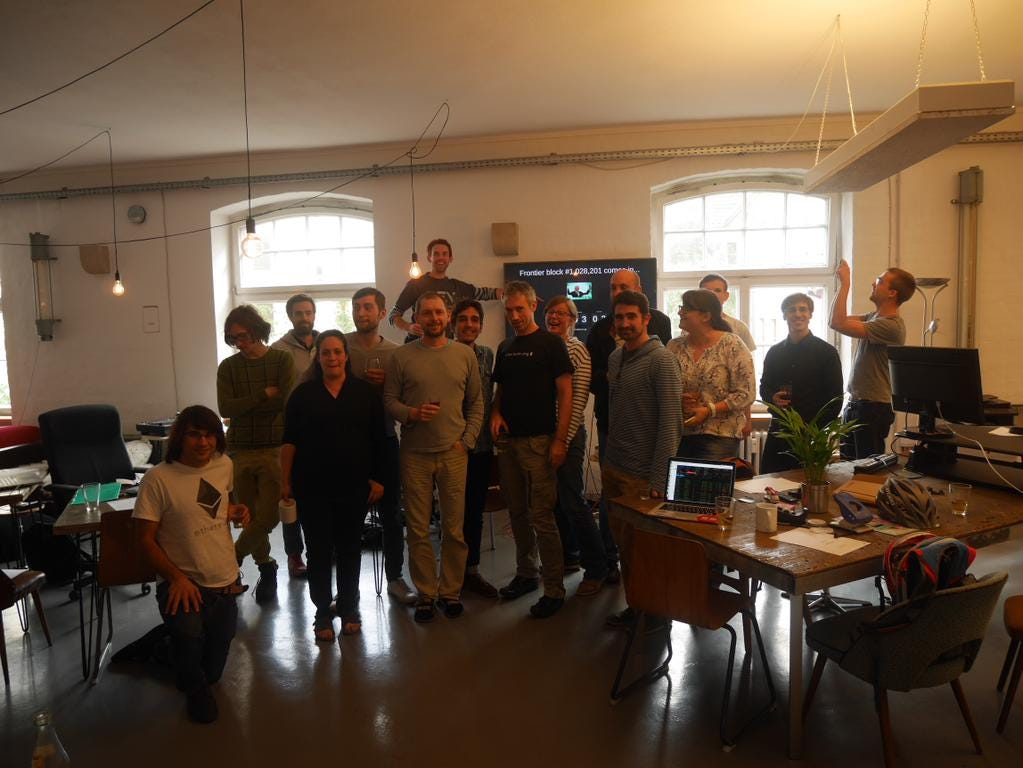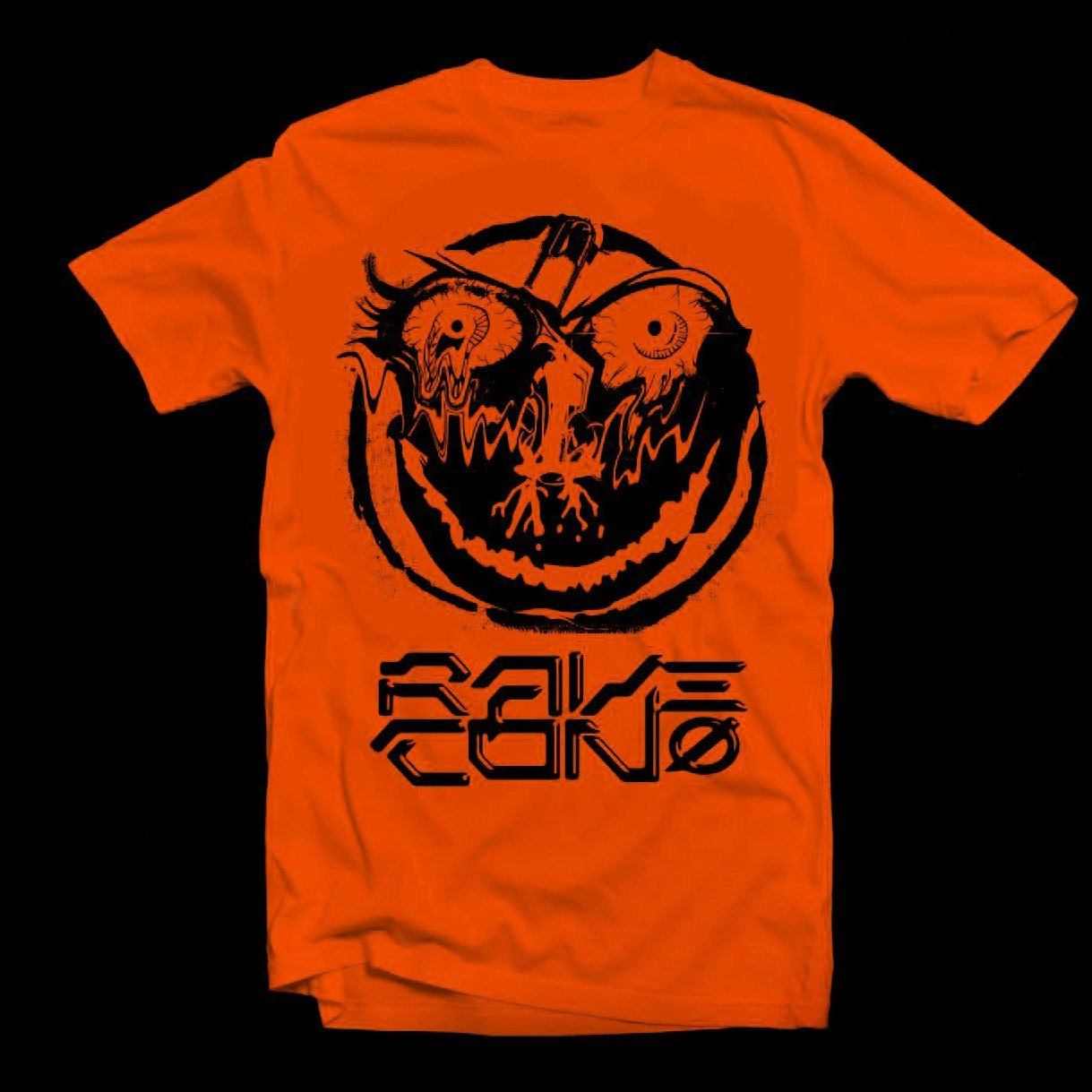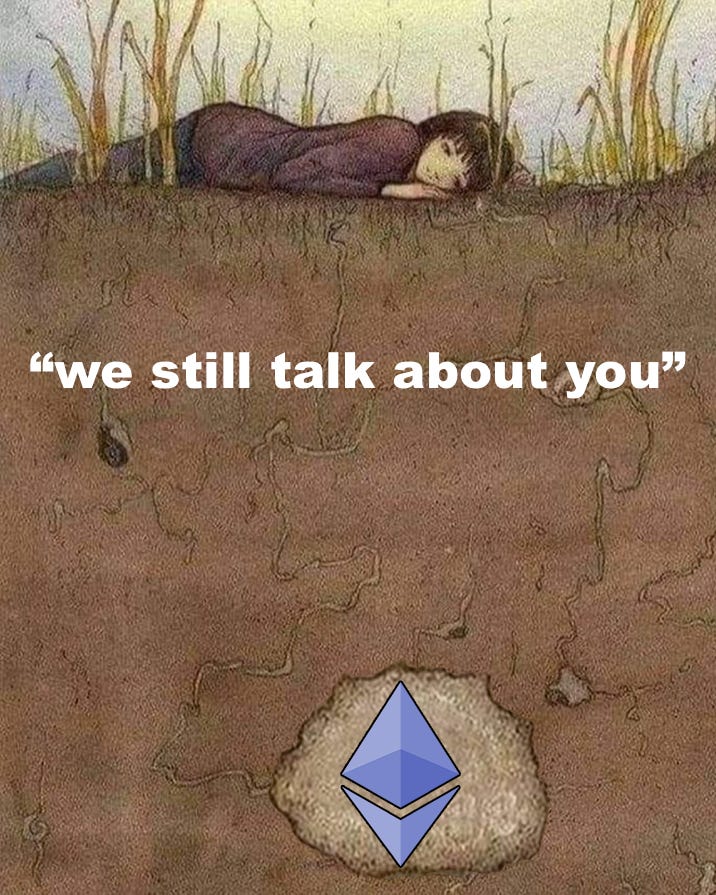Ethereum is loved because it represents an island of idealism in a sea of grift.
Ethereum is hated because its price refuses to go up.
And from this tension emerges a complicated brand.
Ethereum is the brand the largest number of crypto natives are invested in: both literally, because they own Ether (Ethereum’s currency) and emotionally, because they care (or used to care) about the core values the project is aligned with, namely decentralization, immutability, and open source.
But first, a quick Ethereum primer:
Ethereum was conceptualized in 2013 by Vitalik Buterin, a young programmer working as a writer for Bitcoin Magazine. Bitcoin’s conception is immaculate with its unknown pseudonymous founder, but Ethereum has some great lore too. While playing the online game World of Warcraft, Buterin's character had a spell he frequently used suddenly removed by the game developers. This incident in 2010 profoundly impacted young Vitalik, as he felt powerless over the arbitrary decision. Reflecting on this, he realized the potential of using blockchain technology, the central innovation of Bitcoin, to give users more control and create decentralized applications that could run exactly as programmed without any possibility of third-party interference (on the blockchain, your spell becomes immutable).
Ethereum went live in 2015. Unlike Bitcoin, Ethereum includes a programming language that allows developers to write more complex smart contracts—self-executing contracts with the terms directly written into code—enabling a vast range of applications from gaming to electronic voting to decentralized finance to digital assets to collectables and beyond.
If Bitcoin was proof of concept for digital currency, then Ethereum's introduction of smart contracts really created crypto as we know it. Idealistically, it laid the foundation for a shared imaginary, a frontier of decentralized applications and digital sovereignty. And practically, as the most deployed smart contracts on Ethereum are those for creating ever new tokens and NFTs, unlocking an unforeseen world of speculation on digital assets.
However, this digital frontier as imagined by early Ethereans has persistently remained around the corner for 10 years now. To this date the things that have found real product-market-fit via Ethereum are limited: stablecoins (most of which actually happens outside Ethereum), some DeFi (most notably borrowing/lending), and trading of tokens (this is also mostly on rival chain Solana now). That’s really about it.
In crypto, the majority of brand equity is literal equity. Bad price = bad brand, and vice versa (with minor exceptions). Relative to other major cryptos, most notably Bitcoin and Solana, the price of Ethereum has seen only a modest appreciation over the past two years. Consequently, one of Ethereum’s biggest brand problems in recent times is its failure to produce a bubble at a magnitude crypto participants have come to expect. As one of our clients said recently: the bubble is crypto’s true product.
The price of Ether refusing to go up is weighing on the brand. But Ethereum today also has a distinct vibe problem. The animating early vision of Ethereum was that of a “world computer”; a utopian idea of a world of abundance, decentralizing financial and social systems through applications used by millions, running on a digital substrate distributed across hundreds of thousands of machines around the globe. This vision, and by extension, version of the brand isn’t dead. In a survey we distributed to some of our Ethereum-aligned friends, Ethereum was described as:
“A noble attempt to give crypto a purpose”
“The Burning Man of money, or the 4chan of finance”
“a romanticized … future characterized by an infinite digital substrate, where a self-governing technical elite can remake society”
But within the same survey – or anywhere else where Ethereum’s brand is being discussed today – much more common were descriptions such as “World Economic Forum crypto,” “Microsoft but worse,” “EU of crypto,” “beta,” “soy,” etc.
Some of this sentiment can be attributed to the actions and public perception of the Ethereum Foundation (EF), the non-profit structure set up to fund protocol development, support ecosystem growth and general advocacy. In an ultra-competitive and adversarial space, the EF appears to have positioned itself outside the real life dynamics and pace of crypto. While competitors focus on shipping product and ruthless commercialization, the EF waxes lyrical about infinite gardens in a way that suggests Ethereum has reached an end-of-history style readiness, rather than being in an all out cryptoeconomic war with other blockchains for users, capital and elusive mainstream adoption. Coupled with dated aesthetics and notoriously slow execution timelines for protocol upgrades, comparisons between the blockchain the EF stewards and crumbling liberal world order institutions don’t come as a surprise.
This hasn’t gone unnoticed by key Ethereum figureheads, most notably Vitalik Buterin himself, who recently staged an intervention. (A summary on the current EF drama.) Interestingly enough, in the linked tweet Vitalik mentions as a specific non-goal of his intervention: “Execute some kind of ideological / vibez pivot from feminized wef soyboy mentality to bronze age mindset” Presumably, what he is referring to is refusing a brand pivot similar to Mark Zuckerberg; from low T android to Trump-aligned manosphere life coach.
But what in fact is the “soy” in Ethereum’s brand?
On one level it has to do with the aura of certain key personalities and KOLs in the ecosystem. On another, it has to do with the architecture of Ethereum itself. As mentioned earlier, most of the brand equity in crypto is simply a derivative of the price of the associated token. If the price of Ether was $10k today (about 3x from what it actually is at the time of writing), the mishaps and politics of the Ethereum Foundation would be of little concern to the wider crypto public. The cringe would be offset by the chad of the price.
So what makes it appear weak? Without going too much into technical detail, unlike its competitor Solana (for example), Ethereum has chosen to scale its capacity and throughput via “Layer 2s”. What this means is instead of all activity happening on the Ethereum blockchain itself, the “Layer 1”, lighter, faster and less secure blockchains can use Ethereum for their security (i.e. settle on Ethereum L1). One practical consequence of this architecture is that Ethereum leaks economic value to these Layer 2 blockchains, hampering the appreciation of its own token, Ether (ETH). This happens both because Ethereum earns less fees as most of the activity now happens on Layer 2s and because of brand dilution: the Ethereum ecosystem now has dozens of base tokens representing different Layer 2s for a user / investor / speculator to choose from, rather than a singular focus on ETH. This dynamic is well illustrated in this slide by Ameen Soleimani.
Ok, we’ve outlined Ethereum’s most pressing brand problems. But it wasn’t always like this.
In 2014, encountering the name Ethereum for the first time on a funky turquoise and spicy green digital flyer advertising a talk by Vitalik Buterin in New York, it felt cool and distinctly different from the scam-ridden early crypto filled with Bitcoin copycats (almost always named ___coin). It seemed (and was!) more serious, a name fitting a new digital frontier. William Gibson in the 1980s or 90s certainly wouldn’t have called a digital money “Bitcoin”. But he might’ve called a smart contract platform (if he had come up with one) Ethereum.
Seeing Vitalik speak at the event felt like witnessing a new type of human, a 20-year-old savant homo cryptonomicus; a native in an emerging new world almost no one understood yet.
Ethereum culture between 2015-18 was electrifying. It seemed to be reimagining the whole digital – and by extension real – world in a matter of few years: smart contract locks, raves that owned themselves, a decentralized crypto VC megafund simply known as the DAO, prediction markets for everything, whole nation states running their digital services on Ethereum, etc. It seemed like a defining moment for the next stage of the internet and the beginning of a truly virtual economy.
One of the main early crypto innovations was the ICO, the initial coin offering, where projects could issue and sell their token to the general public to fund their own development. Those who had participated in the original Ethereum ICO in 2014 and held onto their tokens had become rich by 2017 (the price of ETH going from $0.3 to $1400 in this period – or 4666x).
2017 saw the first crypto bubble that caught real mainstream attention. ICOs for projects building applications on (mostly) Ethereum were popping up left and right. What started with serious projects with – at least initially – honest intentions, the ICO boom quickly devolved into a scam-fest of epic proportions (Dentacoin, anyone?). Yet, at the time, the FOMO was real as it felt like a new internet was being built before our eyes; every online business model and digital service imminently disrupted or killed by its decentralized competitor. You had to jump on the train now, or be left behind.
However, with the bubble popping in 2018, it turned out the world and the tech wasn’t quite ready for the crypto vision largely led and inspired by Ethereum just yet.

In 2021, Ethereum, clad in rainbows and unicorns, found itself at the center of a new crypto bubble. This time the vision of the imminent crypto future that was being bet on was significantly diminished. It wasn’t about decentralized asteroid mining funding or moving whole industrial verticals on the blockchain like it was in 2017, but “web3”, an originally much more expansive term ultimately reduced to referring to an onchain creator economy enabled via NFTs (issued on Ethereum), DAOs and community (3,3). Again the FOMO was real. It seemed like the last opportunity to buy a Bored Ape under $250,000. (Tragically, this was perhaps also Ethereum’s biggest mainstream brand moment as many claimed it was “boiling the oceans” through the energy expenditure of NFT mints.)
In 2022 it turned out the world and the tech weren’t quite ready yet this time either.
Now it’s been four more years, but this time it’s debatable whether we are in a crypto bubble in 2025 – especially if you have chosen ETH as your vehicle. What is clear however is the collapse of any pretense around crypto’s utility. Outside of Bitcoin, stablecoins, some decentralized finance platforms, and questionable AI DApps/agents, the only notable trend remaining is memecoins, which are largely being issued on Solana. It is fair to say the original vision laid out by Ethereum ten years ago has panned out only in a very limited sense. 2017 and 2021 were picture perfect financial bubbles around an emerging technology. Yet the manias were fuelled by a now lost genuine optimism for a future aligned with Ethereum’s founding vision.
Ethereum has a generational brand problem.
One of the fundamental dynamics of crypto is the tension between the scarcity of a single asset and the unrestricted inflation in the overall number of assets (something we wrote about at length in the Nemesis Guide to Being Early, Summer ‘24 Edition ). Yes, there might be only 21 million bitcoin ever to be mined, but there’s a million other coins to choose from. For your coin to go up, someone else has to choose it over a million alternatives.
The two single biggest wealth creation events in crypto were the births of Bitcoin in 2009 and Ethereum five years later. Both made many early adopters, many who had no prior investment experience or interest, unfathomably wealthy.
To paraphrase K-HOLE’s YOUTH MODE: "men tend to dress the way they did when they first got laid”. There’s an analogous relationship between people (men) and the asset that first made them rich. Early Ethereans became rich by unironically believing in something. A feat that has become harder and harder to repeat since then. This has created a persistent sanctimonius myopia where many influential Ethereum OGs with generational wealth have a hard time empathizing with newer crypto participants and the nihilistic, zero sum dynamics of crypto today. They fail to see why someone wouldn’t want to wear their metaphorical rainbow snuggie – i.e. buy the same asset for the same reasons that they did (which has appreciated 10000x since they bought it themselves) or why public goods and protocol governance doesn’t have the same appeal to younger degenerates. Worthy things, but not useful to someone trying to make it.
Brand Strategies
It is not exactly within our area of expertise to give recommendations on Ethereum’s architecture, protocol upgrades, or EF politics. We unfortunately also can’t make its price go up, which would largely alleviate any need for brand interventions. Yet at Nemesis we consider Ethereum a net positive technology and would like to see it succeed. How could its brand problems be addressed – even if there are few centralized levers to pull?
To simplify, Ethereum has two main audiences, current crypto users and potential future crypto users (including financial institutions, corporations, even states). In a narrow sense, in the case of both audiences, Ethereum is fighting for attention between Bitcoin and Solana, both of which are currently winning their respective fights with Ethereum.
As a fun little exercise, with a little help from the hive mind (“what first comes to mind”) we generated associative semiotic clusters for Bitcoin, Ethereum and Solana:
Bitcoin:
Libertarian, multipolar world, doomer, guns, carnivores, Blackrock, macro, cult, Austrian economics, cocaine, “swarm of cyber hornets serving the goddess of wisdom”, Michael Saylor, Gen X
Ethereum:
Radical centrists, EA, Brooklyn, hipster, global, unicorns, polycule, vegan, d/acc, lightmode, credibly neutral, “Infinite Garden”, Vitalik, Millennial, elitist, .org
Solana:
Purely market driven, brain rot, internet pace, degen, American, e/acc, darkmode, ruthlessly commercial, “Nasdaq at the Speed of Light”, Ansem, Zoomer, populist, Trump, .com
What emerges is a picture of Ethereum being systematically associated with the losing side of today’s cultural, political and economic battles and its rivals on the winning side.
A naive fix to this would be some kind of performative chad makeover for Vitalik (or an “ideological / vibez pivot from feminized wef soyboy mentality to bronze age mindset”). This would obviously be inauthentic and a mistake. But Ethereum shouldn’t appear weaker than it is either.
Three brand provocations for Ethereum:
MORE APPROPRIATELY SCHIZO-NATIVE COMMS
Ethereum’s original vision remains radical, even if it hasn’t come to pass (yet). One can have an cypherpunk, anarchocapitalist interpretation of it, or you could have a radical leftist one – among many other ideological alignments. What the vision doesn’t accommodate as easily is a continuation of the (neo)liberal status quo – yet, to its peril, is associated with it. Ethereum’s narrative and comms should speak in a voice more native to a fractured, radicalized, volatile new order, whether it’s degens, suits or activists.
VITALIKMAXXING
If there’s one thing that has remained a constant positive force and source of goodwill for Ethereum during the past 10 years, is its true founder Vitalik Buterin. The widely expressed frustration around Ethereum and its brand stems from people actually caring about it; for Ethereum to fail would mean for a widely disseminated and loved vision of crypto, embodied by Vitalik, to fail. A large reason the wider crypto audience cares so deeply is Vitalik’s seemingly uncorrupted character. In a world where so many initially idealistically driven tech founders, once gaining enough money and power, become evil or grifters (look at some of Ethereum’s co-founders lol) Vitalik appears uncorruptable and motivated by doing the right thing. A Chad Vitalik isn’t required. The more assertive and opinionated tone he has assumed in his comms recently is great and we wish to see it continue. Vitalik’s Milady alignment is a questionable move. We applaud being less strict about credible neutrality and the contrast with peak unicorn rainbow era Ethereum culture. Yet the ROI seems bad as it runs the risk of alienating individuals valuable to the ecosystem. Ethereum has no taglines or calling cards, so in that vacuum even the phrase “milady” is a rallying cry. In any case, Vitalik is the single most valuable brand asset Ethereum has. Don’t be shy about it. The more visible leadership he’s willing to assume the better.
GO CRAZY WITH THE VISUAL ID
Ethereum is a great name and the logo is fine (this is actually interesting), but since its inception all “official” visual brand assets have been incredibly uninspired and not worthy of the project’s degree of ambition. The current WAGMI-era illustrations on Ethereum.org are dated and make what’s supposed to be a world computer look like a DTC brand from yesteryear. The visual branding isn’t credibly neutral, it’s credibly lame. To a degree this has been offset by some ecosystem brand highlights, but overall, crypto brands remain on average terrible (we’re speaking specifically about the designed aspects of brands here). Obviously the EF and Ethereum.org don’t need to be overtly branded or loud. But given the massive wealth in the ecosystem and its relatively low cost, there’s no need for Ethereum’s key entities and touch points to *not* have the world’s most sophisticated visual brand system, on par with Ethereum’s ambition.
Thanks for reading! If you have any thoughts on this or would like to work together on a project or workshop, get in touch at info@nemesis.global













